Exploiting Laser-Induced Graphene Composites as Substrates for Copper-Mediated Nitrate Reduction
Abstract
:1. Introduction
2. Materials and Methods
3. Results and Discussion
3.1. LIG Characterization
3.2. LIG–Copper Characterization
3.3. Electrochemical Response to Nitrate
3.4. Water Sample Analysis
3.5. Performance Comparison
4. Conclusions
Author Contributions
Funding
Data Availability Statement
Conflicts of Interest
References
- Singh, S.; Anil, A.G.; Kumar, V.; Kapoor, D.; Subramanian, S.; Singh, J.; Ramamurthy, P.C. Nitrates in the environment: A critical review of their distribution, sensing techniques, ecological effects and remediation. Chemosphere 2022, 287, 131996. [Google Scholar] [CrossRef] [PubMed]
- Patel, N.; Srivastav, A.L.; Patel, A.; Singh, A.; Singh, S.K.; Chaudhary, V.K.; Singh, P.K.; Bhunia, B. Nitrate contamination in water resources, human health risks and its remediation through adsorption: A focused review. Environ. Sci. Pollut. Res. 2022, 29, 69137–69152. [Google Scholar] [CrossRef] [PubMed]
- Jiang, C.; He, Y.; Liu, Y. Recent advances in sensors for electrochemical analysis of nitrate in food and environmental matrices. Analyst 2020, 145, 5400–5413. [Google Scholar] [CrossRef] [PubMed]
- Flores, M.; Toldrá, F. Chemistry, safety, and regulatory considerations in the use of nitrite and nitrate from natural origin in meat products. Meat Sci. 2021, 171, 108272. [Google Scholar] [CrossRef] [PubMed]
- Majou, D.; Christieans, S. Mechanisms of the bactericidal effects of nitrate and nitrite in cured meats. Meat Sci. 2018, 145, 273–284. [Google Scholar] [CrossRef] [PubMed]
- Nitrate and Nitrite in Drinking-Water. Background Document for Development of WHO Guidelines for Drinking-Water Quality. World Health Organization. 2003. Available online: https://apps.who.int/iris/bitstream/handle/10665/75380/WHO_SDE_WSH_04.03_56_eng.pdf (accessed on 30 May 2023).
- Tan, J.D.; Anastasi, A.; Chandra, S. Electrochemical detection of nitrate, nitrite and ammonium for on-site water quality monitoring. Curr. Opin. Electrochem. 2022, 32, 100926. [Google Scholar] [CrossRef]
- Amali, R.; Lim, H.; Ibrahim, I.; Huang, N.; Zainal, Z.; Ahmad, S. Significance of nanomaterials in electrochemical sensors for nitrate detection: A review. Trends Environ. Anal. Chem. 2021, 31, e00135. [Google Scholar] [CrossRef]
- Mahmud, M.A.P.; Ejeian, F.; Azadi, S.; Myers, M.; Pejcic, B.; Abbassi, R.; Razmjou, A.; Asadnia, M. Recent progress in sensing nitrate, nitrite, phosphate, and ammonium in aquatic environment. Chemosphere 2020, 259, 127492. [Google Scholar] [CrossRef]
- Li, D.; Wang, T.; Li, Z.; Xu, X.; Wang, C.; Duan, Y. Application of Graphene-Based Materials for Detection of Nitrate and Nitrite in Water—A Review. Sensors 2020, 20, 54. [Google Scholar] [CrossRef]
- Marlinda, A.R.; An’amt, M.N.; Yusoff, N.; Sagadevan, S.; Wahab, Y.A.; Johan, M.R. Recent progress in nitrates and nitrites sensor with graphene-based nanocomposites as electrocatalysts. Trends Environ. Anal. Chem. 2022, 34, e00162. [Google Scholar] [CrossRef]
- Kim, M.-Y.; Lee, K.H. Electrochemical Sensors for Sustainable Precision Agriculture—A Review. Front. Chem. 2022, 10, 848320. [Google Scholar] [CrossRef]
- Yin, H.; Cao, Y.; Marelli, B.; Zeng, X.; Mason, A.J.; Cao, C. Soil Sensors and Plant Wearables for Smart and Precision Agriculture. Adv. Mater. 2021, 33, 2007764. [Google Scholar] [CrossRef] [PubMed]
- Gutiérrez-Cruz, A.; Ruiz-Hernández, A.R.; Vega-Clemente, J.F.; Luna-Gazcón, D.G.; Campos-Delgado, J. A review of top-down and bottom-up synthesis methods for the production of graphene, graphene oxide and reduced graphene oxide. J. Mater. Sci. 2022, 57, 14543–14578. [Google Scholar] [CrossRef]
- Choi, S.H.; Yun, S.J.; Won, Y.S.; Oh, C.S.; Kim, S.M.; Kim, K.K.; Lee, Y.H. Large-scale synthesis of graphene and other 2D materials towards industrialization. Nat. Commun. 2022, 13, 1484. [Google Scholar] [CrossRef]
- Zhang, Y.; Huang, D.; Duan, Y.; Chen, H.; Tang, L.; Shi, M.; Li, Z.; Shi, H. Batch production of uniform graphene films via controlling gas-phase dynamics in confined space. Nanotechnology 2021, 32, 105603. [Google Scholar] [CrossRef]
- Lin, J.; Peng, Z.; Liu, Y.; Ruiz-Zepeda, F.; Ye, R.; Samuel, E.L.G.; Yacaman, M.J.; Yakobson, B.I.; Tour, J.M. Laser-induced porous graphene films from commercial polymers. Nat. Commun. 2014, 5, 5714. [Google Scholar] [CrossRef] [PubMed]
- Chyan, Y.; Ye, R.; Li, Y.; Singh, S.P.; Arnusch, C.J.; Tour, J.M. Laser-Induced graphene by multiple lasing: Toward electronics on cloth, paper, and food. ACS Nano 2018, 12, 2176–2183. [Google Scholar] [CrossRef] [PubMed]
- Barber, R.; Cameron, S.; Devine, A.; McCombe, A.; Pourshahidi, L.K.; Cundell, J.; Roy, S.; Mathur, A.; Casimero, C.; Papakonstantinou, P.; et al. Laser induced graphene sensors for assessing pH: Application to wound management. Electrochem. Commun. 2021, 123, 106914. [Google Scholar] [CrossRef]
- Karousos, N.; Chong, L.C.; Ewen, C.; Livingstone, C.; Davis, J. Evaluation of a multifunctional indicator for the electroanalytical determination of nitrite. Electrochim. Acta 2005, 50, 1879–1884. [Google Scholar] [CrossRef]
- Pletcher, D. A First Course in Electrode Processes; The Electrochemical Consultancy: Romsey, UK, 1991. [Google Scholar]
- Compton, R.G.; Banks, C.E. Understanding Voltammetry, 2nd ed.; Imperial College Press: London, UK, 2011. [Google Scholar]
- Casimero, C.; Hegarty, C.; McGlynn, R.J.; Davis, J. Ultrasonic exfoliation of carbon fiber: Electroanalytical perspectives. J. Appl. Electrochem. 2020, 50, 383–394. [Google Scholar] [CrossRef]
- Kava, A.A.; Henry, C.S. Exploring carbon particle type and plasma treatment to improve electrochemical properties of stencil-printed carbon electrodes. Talanta 2021, 221, 121553. [Google Scholar] [CrossRef]
- Pankratova, G.; Pan, J.Y.; Keller, S.S. Impact of plasma-induced surface chemistry on electrochemical properties of microfabricated pyrolytic carbon electrodes. Electrochim. Acta 2022, 410, 139987. [Google Scholar] [CrossRef]
- Ferrari, A.C.; Meyer, J.C.; Scardaci, V.; Casiraghi, C.; Lazzeri, M.; Mauri, F.; Piscanec, S.; Jiang, D.; Novoselov, K.S.; Roth, S.; et al. Raman spectrum of graphene and graphene layers. Phys. Rev. Lett. 2006, 97, 187401. [Google Scholar] [CrossRef]
- Nguyen, V.T.; Le, H.D.; Ngo, T.T.T.; Le, D.Q.; Nguyen, X.N.; Phan, N.M. Synthesis of multi-layer graphene films on copper tape by atmospheric pressure chemical vapor deposition method. Adv. Nat. Sci. Nanosci. Nanotechnol. 2013, 4, 035012. [Google Scholar] [CrossRef]
- Rosenburg, F.; Ionescu, E.; Nicoloso, N.; Riedel, R. High-Temperature Raman Spectroscopy of Nano-Crystalline Carbon in Silicon Oxycarbide. Materials 2018, 11, 93. [Google Scholar] [CrossRef]
- Gao, Z.; Zhu, J.; Rajabpour, S.; Joshi, K.; Kowalik, M.; Croom, B.; Schwab, Y.; Zhang, L.; Bumgardner, C.; Brown, K.R.; et al. Graphene reinforced carbon fibers. Sci. Adv. 2020, 6, eaaz4191. [Google Scholar] [CrossRef]
- Childres, I.; Jauregui, L.A.; Park, W.; Caoa, H.; Chena, Y.P. Raman Spectroscopy of Graphene and Related Materials. In New Developments in Photon and Materials Research; Nova Science Publishers Inc.: New York, NY, USA, 2013; pp. 403–418. [Google Scholar]
- Duy, L.X.; Peng, Z.; Li, Y.; Zhang, J.; Ji, Y.; Tour, J.M. Laser-induced graphene fibers. Carbon 2018, 126, 472–479. [Google Scholar] [CrossRef]
- Huang, L.; Cheng, L.; Ma, T.; Zhang, J.; Wu, H.; Su, J.; Song, Y.; Zhu, H.; Liu, Q.; Zhu, M.; et al. Direct Synthesis of Ammonia from Nitrate on Amorphous Graphene with Near 100% Efficiency. Adv. Mater. 2023, 35, e2211856. [Google Scholar] [CrossRef] [PubMed]
- Cheng, L.; Ma, T.; Zhang, B.; Huang, L.; Guo, W.; Hu, F.; Zhu, H.; Wang, Z.; Zheng, T.; Yang, D.-T.; et al. Steering the Topological Defects in Amorphous Laser-Induced Graphene for Direct Nitrate-to-Ammonia Electroreduction. ACS Catal. 2022, 12, 11639–11650. [Google Scholar] [CrossRef]
- Sookhakian, M.; Teridi, M.A.M.; Tong, G.B.; Woi, P.M.; Khalil, M.; Alias, Y. Reduced Graphene Oxide/Copper Nanoparticle Composites as Electrochemical Sensor Materials for Nitrate Detection. ACS Appl. Nano Mater. 2021, 4, 12737–12744. [Google Scholar] [CrossRef]
- Chen, J.-Q.; Ye, X.-X.; Zhou, D.; Chen, Y.-X. Roles of Copper in Nitrate Reduction at Copper-Modified Ru/C Catalysts. J. Phys. Chem. C 2023, 127, 2918–2928. [Google Scholar] [CrossRef]
- Li, X.; Zhao, X.; Lv, J.; Jia, X.; Zhou, S.; Huang, Y.; Chang, F.; Zhang, H.; Hu, G. Self-supported porous copper oxide nanosheet arrays for efficient and selective electrochemical conversion of nitrate ions to nitrogen gas. J. Mater. Sci. Technol. 2023, 137, 104–111. [Google Scholar] [CrossRef]
- Pasarakonda, S.L.; Ponnada, S.; Gorle, D.B.; Bose, R.S.C.; Palariya, A.; Kiai, M.S.; Gandham, H.B.; Kathiresan, M.; Sharma, R.K.; Nowduri, A. On the role of graphene oxide in bifunctional Ni/MOF/rGO composites in electrochemical nitrate detection and oxygen evolution reaction. New J. Chem. 2023, 47, 725–736. [Google Scholar] [CrossRef]
- Zhad, H.R.L.Z.; Lai, R.Y. Comparison of nanostructured silver-modified silver and carbon ultramicroelectrodes for electrochemical detection of nitrate. Anal. Chim. Acta 2015, 892, 153–159. [Google Scholar] [CrossRef]
- Li, Y.; Han, H.; Pan, D.; Zhang, P. Fabrication of a Micro-Needle Sensor Based on Copper Microspheres and Polyaniline Film for Nitrate Determination in Coastal River Waters. J. Electrochem. Soc. 2019, 166, B1038–B1043. [Google Scholar] [CrossRef]
- Garland, N.T.; McLamore, E.S.; Cavallaro, N.D.; Mendivelso-Perez, D.; Smith, E.A.; Jing, D.; Claussen, J.C. Flexible Laser-Induced Graphene for Nitrogen Sensing in Soil. ACS Appl. Mater. Inter. 2018, 10, 39124–39133. [Google Scholar] [CrossRef] [PubMed]
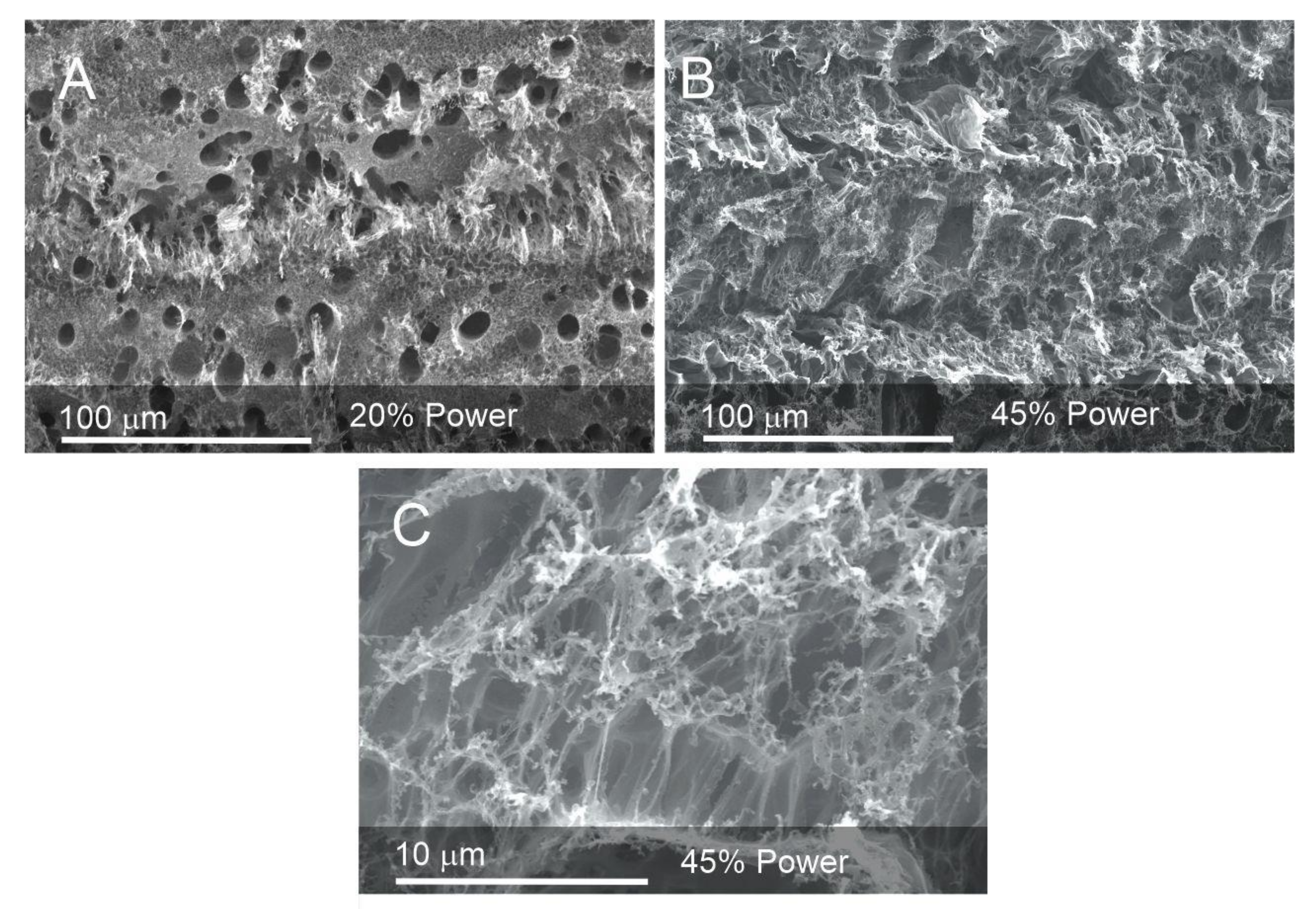
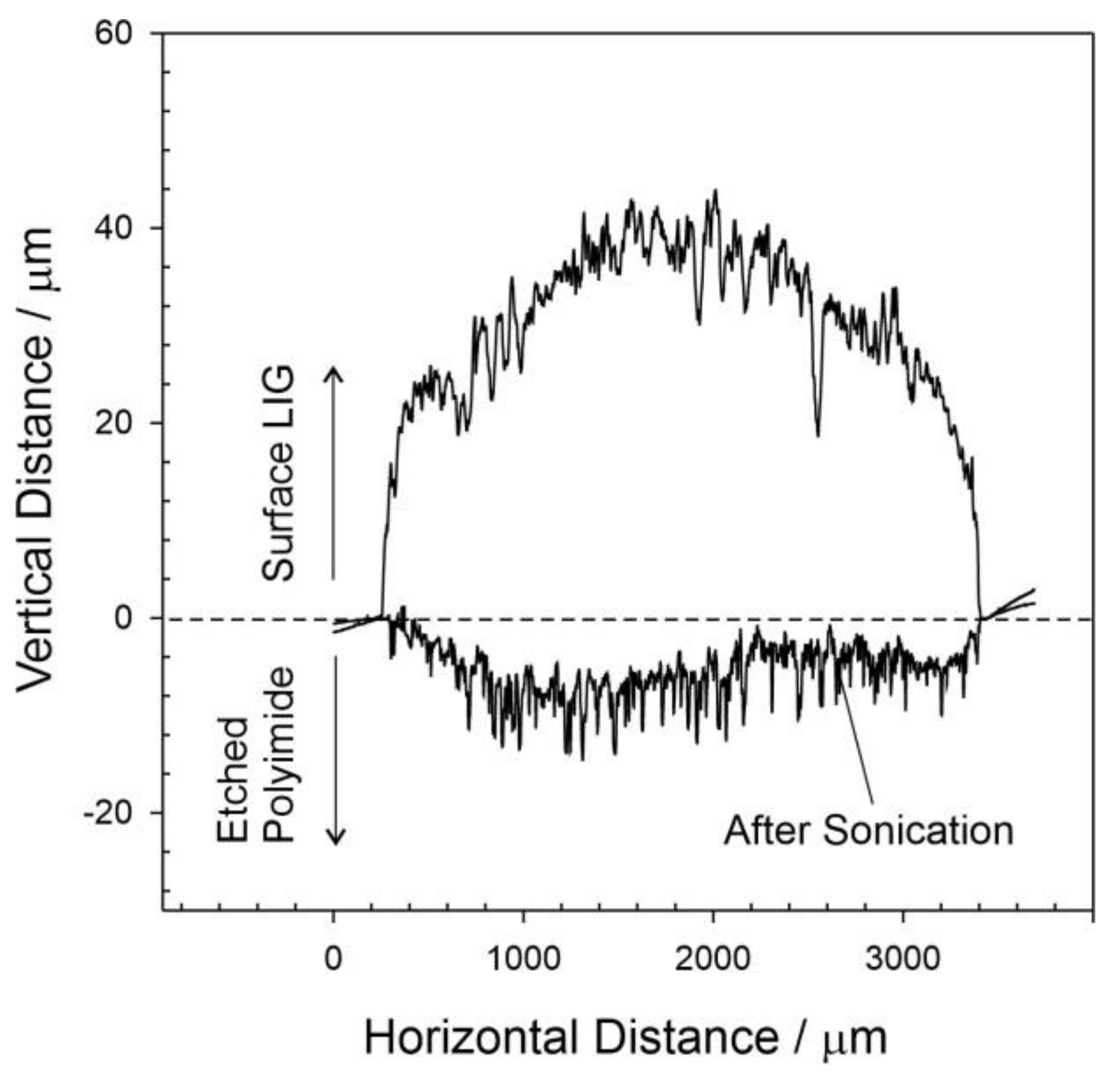
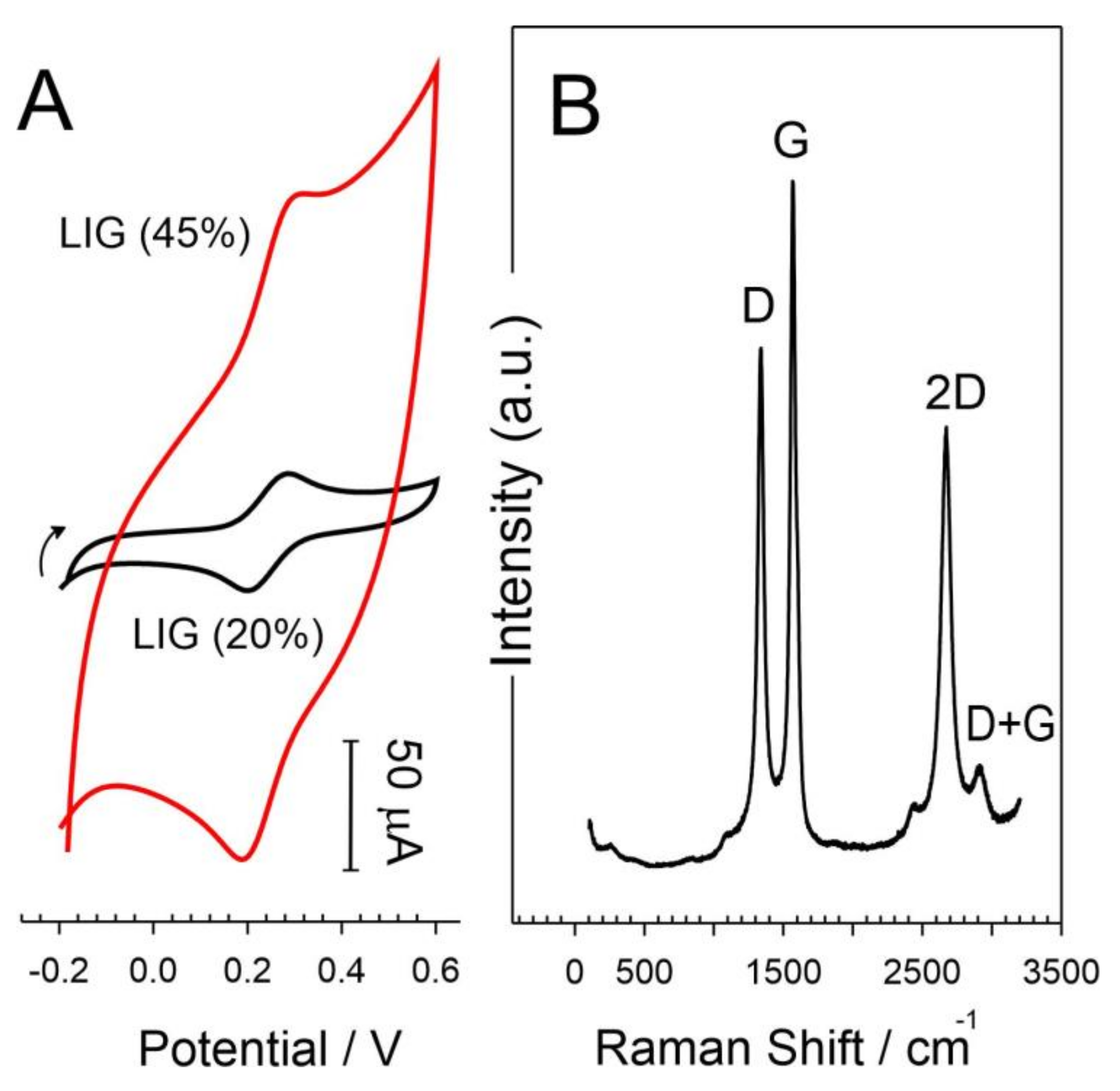
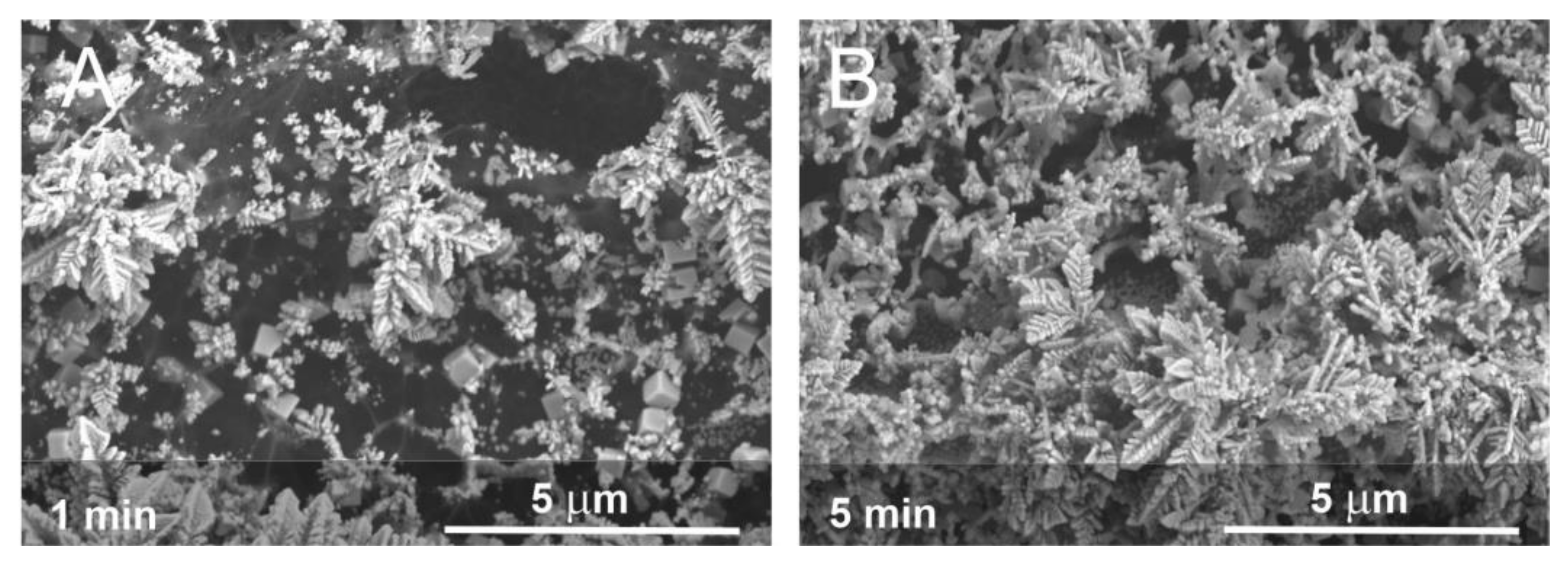




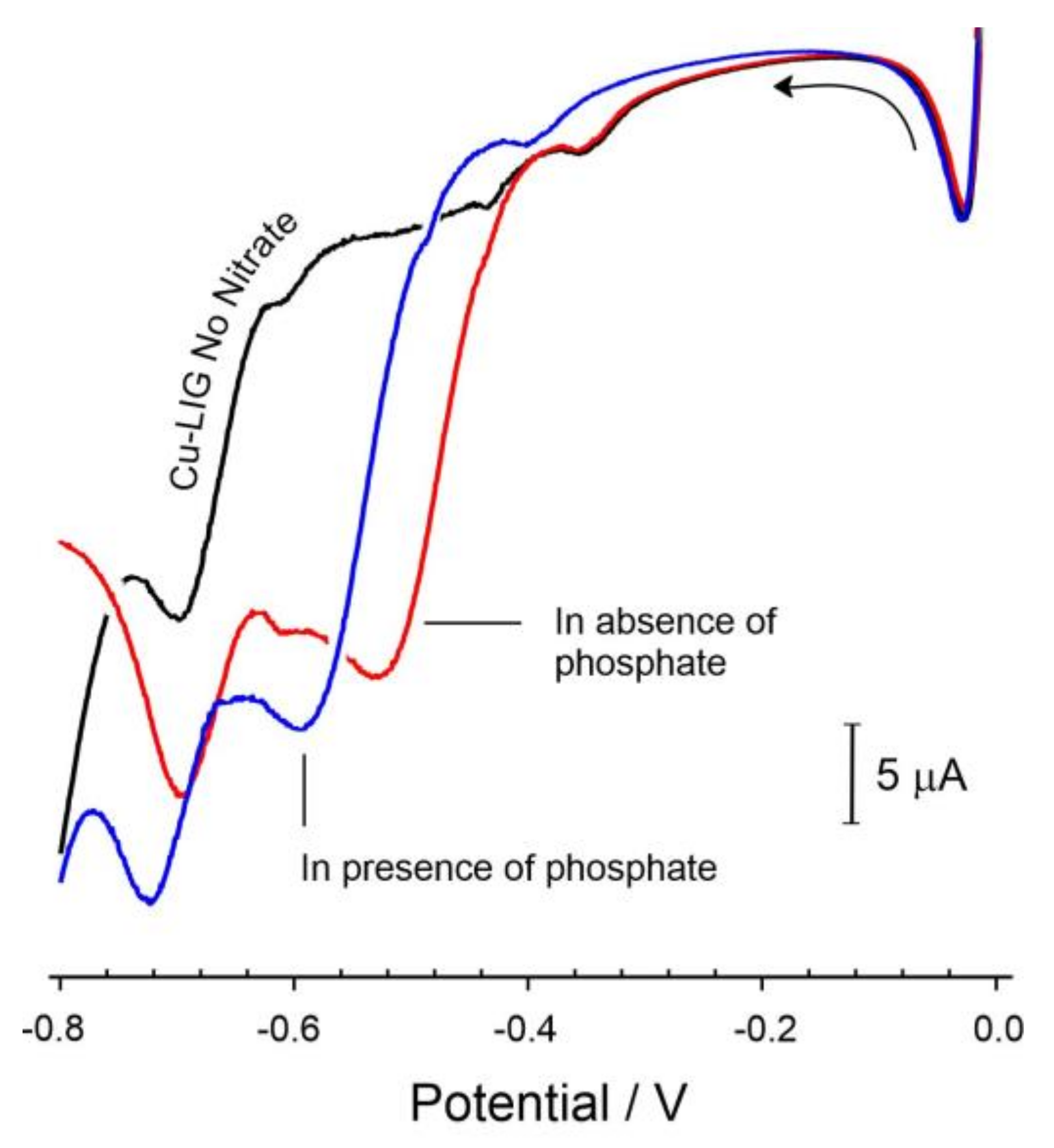
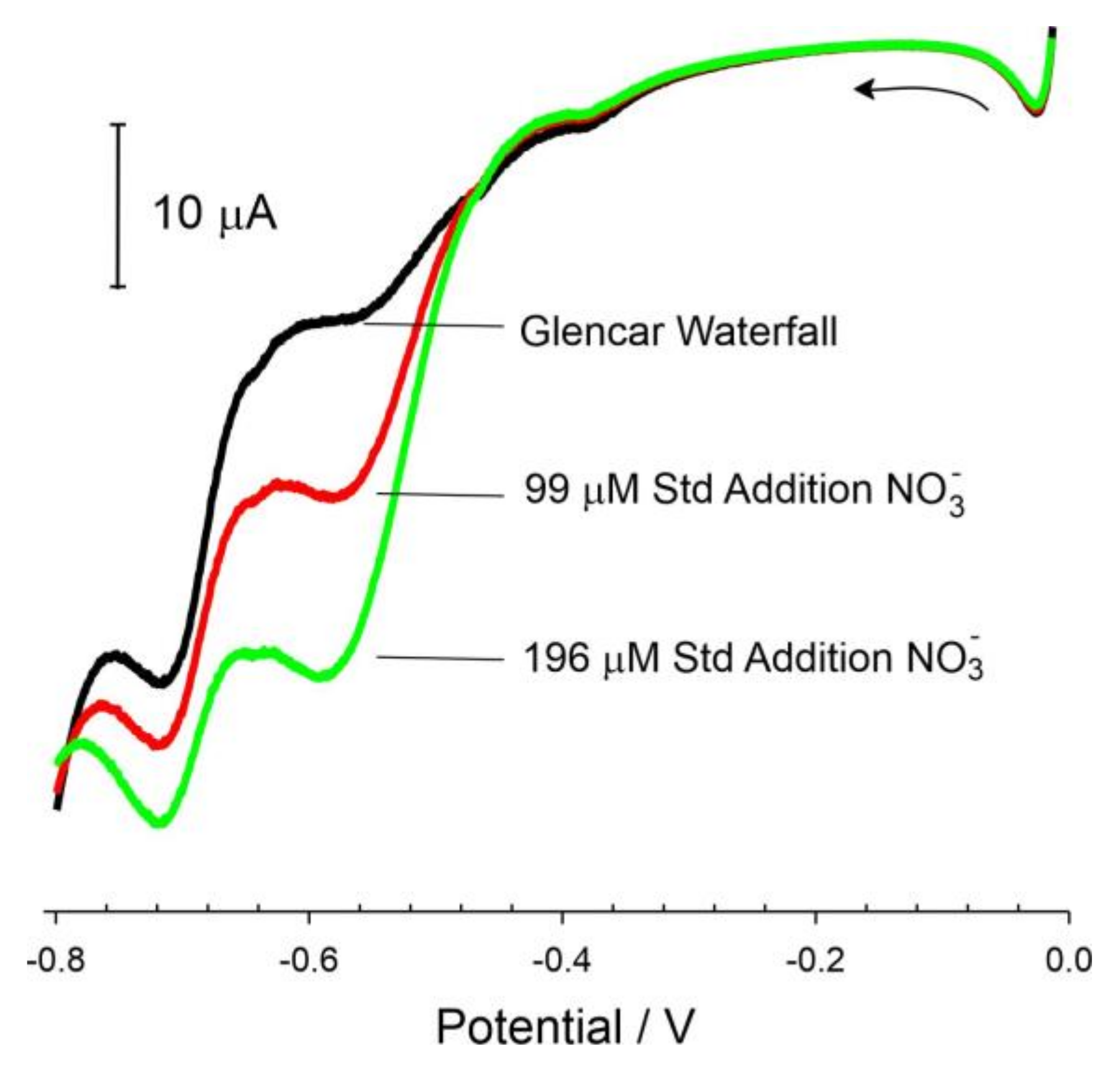
| Sample | Nitrate Reductase UV-Vis Assay /μM | Cu-LIG Electrochemical Assay /μM |
|---|---|---|
| Tobernalt Holy Well | 458 ± 6 | 455 ± 8 |
| Glencar Waterfall | 174 ± 2 | 173 ± 6 |
| Composite | Method | Potential /V vs. AgCl | LoD /μM | Sample Type | Refs. |
|---|---|---|---|---|---|
| Ni/MOF/rGO | V | −0.6 | 4.08 | Borewell water | [37] |
| D-Ag/IDA | V | −1 | 3.2 | Syn Aquifiers | [38] |
| Cu rGO/ITO | V | −0.6 | 1.875 | Lake Water | [34] |
| Cu MS/PANI | V | −0.55 | 8 | River Water | [39] |
| LIG-PVC TDMAN | P | N/A | 20 | Soil | [40] |
| LIG-Cu | V | −0.6 | 4.7 | Well Water | This work |
Disclaimer/Publisher’s Note: The statements, opinions and data contained in all publications are solely those of the individual author(s) and contributor(s) and not of MDPI and/or the editor(s). MDPI and/or the editor(s) disclaim responsibility for any injury to people or property resulting from any ideas, methods, instructions or products referred to in the content. |
© 2023 by the authors. Licensee MDPI, Basel, Switzerland. This article is an open access article distributed under the terms and conditions of the Creative Commons Attribution (CC BY) license (https://creativecommons.org/licenses/by/4.0/).
Share and Cite
Scott, C.; Gilpin, V.; McCreadie, K.; Davis, J. Exploiting Laser-Induced Graphene Composites as Substrates for Copper-Mediated Nitrate Reduction. J. Compos. Sci. 2023, 7, 397. https://doi.org/10.3390/jcs7090397
Scott C, Gilpin V, McCreadie K, Davis J. Exploiting Laser-Induced Graphene Composites as Substrates for Copper-Mediated Nitrate Reduction. Journal of Composites Science. 2023; 7(9):397. https://doi.org/10.3390/jcs7090397
Chicago/Turabian StyleScott, Cameron, Victoria Gilpin, Karl McCreadie, and James Davis. 2023. "Exploiting Laser-Induced Graphene Composites as Substrates for Copper-Mediated Nitrate Reduction" Journal of Composites Science 7, no. 9: 397. https://doi.org/10.3390/jcs7090397
APA StyleScott, C., Gilpin, V., McCreadie, K., & Davis, J. (2023). Exploiting Laser-Induced Graphene Composites as Substrates for Copper-Mediated Nitrate Reduction. Journal of Composites Science, 7(9), 397. https://doi.org/10.3390/jcs7090397






